Guest migration
Contents
Migration of guests between hosts is a complicated problem with many possible solutions, each with their own positive and negative points. For maximum flexibility of both hypervisor integration, and administrator deployment, libvirt implements several options for migration.
Network data transports¶
There are two options for the data transport used during migration, either the hypervisor's own native transport, or tunnelled over a libvirtd connection.
Hypervisor native transport¶
Native data transports may or may not support encryption, depending on the hypervisor in question, but will typically have the lowest computational costs by minimising the number of data copies involved. The native data transports will also require extra hypervisor-specific network configuration steps by the administrator when deploying a host. For some hypervisors, it might be necessary to open up a large range of ports on the firewall to allow multiple concurrent migration operations.
Modern hypervisors support TLS for encryption and authentication of the migration connections which can be enabled using the VIR_MIGRATE_TLS flag. The qemu hypervisor driver allows users to force use of TLS via the migrate_tls_force knob configured in /etc/libvirt/qemu.conf.
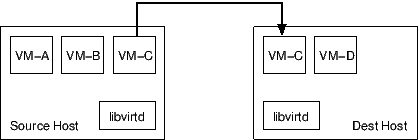
libvirt tunnelled transport¶
Tunnelled data transports will always be capable of strong encryption since they are able to leverage the capabilities built in to the libvirt RPC protocol. The downside of a tunnelled transport, however, is that there will be extra data copies involved on both the source and destinations hosts as the data is moved between libvirtd and the hypervisor. This is likely to be a more significant problem for guests with very large RAM sizes, which dirty memory pages quickly. On the deployment side, tunnelled transports do not require any extra network configuration over and above what's already required for general libvirtd remote access, and there is only need for a single port to be open on the firewall to support multiple concurrent migration operations.
Note: Certain features such as migration of non-shared storage (VIR_MIGRATE_NON_SHARED_DISK), the multi-connection migration (VIR_MIGRATE_PARALLEL), or post-copy migration (VIR_MIGRATE_POSTCOPY) may not be available when using libvirt's tunnelling.
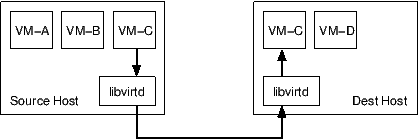
Communication control paths/flows¶
Migration of virtual machines requires close co-ordination of the two hosts involved, as well as the application invoking the migration, which may be on the source, the destination, or a third host.
Managed direct migration¶
With managed direct migration, the libvirt client process controls the various phases of migration. The client application must be able to connect and authenticate with the libvirtd daemons on both the source and destination hosts. There is no need for the two libvirtd daemons to communicate with each other. If the client application crashes, or otherwise loses its connection to libvirtd during the migration process, an attempt will be made to abort the migration and restart the guest CPUs on the source host. There may be scenarios where this cannot be safely done, in which cases the guest will be left paused on one or both of the hosts.
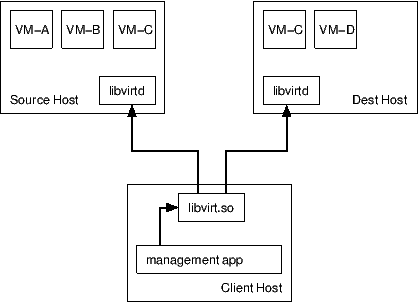
Managed peer to peer migration¶
With peer to peer migration, the libvirt client process only talks to the libvirtd daemon on the source host. The source libvirtd daemon controls the entire migration process itself, by directly connecting the destination host libvirtd. If the client application crashes, or otherwise loses its connection to libvirtd, the migration process will continue uninterrupted until completion. Note that the source libvirtd uses its own credentials (typically root) to connect to the destination, rather than the credentials used by the client to connect to the source; if these differ, it is common to run into a situation where a client can connect to the destination directly but the source cannot make the connection to set up the peer-to-peer migration.
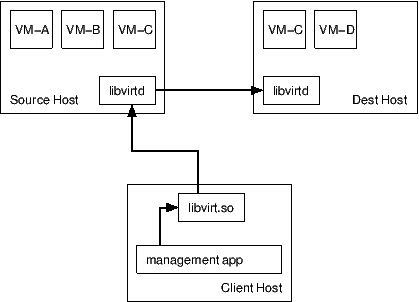
Unmanaged direct migration¶
With unmanaged direct migration, neither the libvirt client or libvirtd daemon control the migration process. Control is instead delegated to the hypervisor's over management services (if any). The libvirt client merely initiates the migration via the hypervisor's management layer. If the libvirt client or libvirtd crash, the migration process will continue uninterrupted until completion.
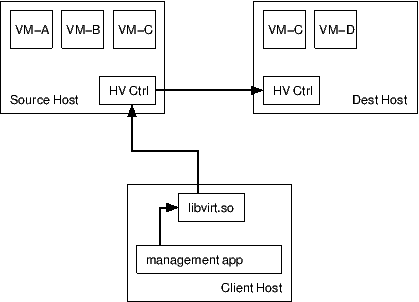
Data security¶
Since the migration data stream includes a complete copy of the guest OS RAM, snooping of the migration data stream may allow compromise of sensitive guest information. If the virtualization hosts have multiple network interfaces, or if the network switches support tagged VLANs, then it is very desirable to separate guest network traffic from migration or management traffic.
In some scenarios, even a separate network for migration data may not offer sufficient security. In this case it is possible to apply encryption to the migration data stream. If the hypervisor does not itself offer encryption, then the libvirt tunnelled migration facility should be used.
Offline migration¶
Offline migration transfers the inactive definition of a domain (which may or may not be active). After successful completion, the domain remains in its current state on the source host and is defined but inactive on the destination host. It's a bit more clever than virsh dumpxml on source host followed by virsh define on destination host, as offline migration will run the pre-migration hook to update the domain XML on destination host. Currently, copying non-shared storage or other file based storages (e.g. UEFI variable storage) is not supported during offline migration.
Migration URIs¶
Initiating a guest migration requires the client application to specify up to three URIs, depending on the choice of control flow and/or APIs used. The first URI is that of the libvirt connection to the source host, where the virtual guest is currently running. The second URI is that of the libvirt connection to the destination host, where the virtual guest will be moved to (and in peer-to-peer migrations, this is from the perspective of the source, not the client). The third URI is a hypervisor specific URI used to control how the guest will be migrated. With any managed migration flow, the first and second URIs are compulsory, while the third URI is optional. With the unmanaged direct migration mode, the first and third URIs are compulsory and the second URI is not used.
Ordinarily management applications only need to care about the first and second URIs, which are both in the normal libvirt connection URI format. Libvirt will then automatically determine the hypervisor specific URI, by looking up the target host's configured hostname. There are a few scenarios where the management application may wish to have direct control over the third URI.
The configured hostname is incorrect, or DNS is broken. If a host has a hostname which will not resolve to match one of its public IP addresses, then libvirt will generate an incorrect URI. In this case the management application should specify the hypervisor specific URI explicitly, using an IP address, or a correct hostname.
The host has multiple network interfaces. If a host has multiple network interfaces, it might be desirable for the migration data stream to be sent over a specific interface for either security or performance reasons. In this case the management application should specify the hypervisor specific URI, using an IP address associated with the network to be used.
The firewall restricts what ports are available. When libvirt generates a migration URI it will pick a port number using hypervisor specific rules. Some hypervisors only require a single port to be open in the firewalls, while others require a whole range of port numbers. In the latter case the management application may wish to choose a specific port number outside the default range in order to comply with local firewall policies.
The second URI uses UNIX transport method. In this advanced case libvirt should not guess a *migrateuri* and it should be specified using UNIX socket path URI: unix:///path/to/socket.
Configuration file handling¶
There are two types of virtual machines known to libvirt. A transient guest only exists while it is running, and has no configuration file stored on disk. A persistent guest maintains a configuration file on disk even when it is not running.
By default, a migration operation will not attempt to modify any configuration files that may be stored on either the source or destination host. It is the administrator, or management application's, responsibility to manage distribution of configuration files (if desired). It is important to note that the /etc/libvirt directory MUST NEVER BE SHARED BETWEEN HOSTS. There are some typical scenarios that might be applicable:
Centralized configuration files outside libvirt, in shared storage. A cluster aware management application may maintain all the master guest configuration files in a cluster filesystem. When attempting to start a guest, the config will be read from the cluster FS and used to deploy a persistent guest. For migration the configuration will need to be copied to the destination host and removed on the original.
Centralized configuration files outside libvirt, in a database. A data center management application may not store configuration files at all. Instead it may generate libvirt XML on the fly when a guest is booted. It will typically use transient guests, and thus not have to consider configuration files during migration.
Distributed configuration inside libvirt. The configuration file for each guest is copied to every host where the guest is able to run. Upon migration the existing config merely needs to be updated with any changes.
Ad-hoc configuration management inside libvirt. Each guest is tied to a specific host and rarely migrated. When migration is required, the config is moved from one host to the other.
As mentioned above, libvirt will not modify configuration files during migration by default. The virsh command has two flags to influence this behaviour. The --undefinesource flag will cause the configuration file to be removed on the source host after a successful migration. The --persistent flag will cause a configuration file to be created on the destination host after a successful migration. The following table summarizes the configuration file handling in all possible state and flag combinations.
Before migration |
Flags |
After migration |
|||||
|---|---|---|---|---|---|---|---|
Source type |
Source config |
Dest config |
--undefinesource |
--persistent |
Dest type |
Source config |
Dest config |
Transient |
N |
N |
N |
N |
Transient |
N |
N |
Transient |
N |
N |
Y |
N |
Transient |
N |
N |
Transient |
N |
N |
N |
Y |
Persistent |
N |
Y |
Transient |
N |
N |
Y |
Y |
Persistent |
N |
Y |
Transient |
N |
Y |
N |
N |
Persistent |
N |
Y (unchanged dest config) |
Transient |
N |
Y |
Y |
N |
Persistent |
N |
Y (unchanged dest config) |
Transient |
N |
Y |
N |
Y |
Persistent |
N |
Y (replaced with source) |
Transient |
N |
Y |
Y |
Y |
Persistent |
N |
Y (replaced with source) |
Persistent |
Y |
N |
N |
N |
Transient |
Y |
N |
Persistent |
Y |
N |
Y |
N |
Transient |
N |
N |
Persistent |
Y |
N |
N |
Y |
Persistent |
Y |
Y |
Persistent |
Y |
N |
Y |
Y |
Persistent |
N |
Y |
Persistent |
Y |
Y |
N |
N |
Persistent |
Y |
Y (unchanged dest config) |
Persistent |
Y |
Y |
Y |
N |
Persistent |
N |
Y (unchanged dest config) |
Persistent |
Y |
Y |
N |
Y |
Persistent |
Y |
Y (replaced with source) |
Persistent |
Y |
Y |
Y |
Y |
Persistent |
N |
Y (replaced with source) |
Migration scenarios¶
Native migration, client to two libvirtd servers¶
At an API level this requires use of virDomainMigrate, without the VIR_MIGRATE_PEER2PEER flag set. The destination libvirtd server will automatically determine the native hypervisor URI for migration based off the primary hostname. To force migration over an alternate network interface the optional hypervisor specific URI must be provided
syntax: virsh migrate GUESTNAME DEST-LIBVIRT-URI [HV-URI] eg using default network interface virsh migrate web1 qemu+ssh://desthost/system virsh migrate web1 xen+tls://desthost/system eg using secondary network interface virsh migrate web1 qemu://desthost/system tcp://10.0.0.1/
Supported by Xen, QEMU, VMware and VirtualBox drivers
Native migration, client to and peer2peer between, two libvirtd servers¶
virDomainMigrate, with the VIR_MIGRATE_PEER2PEER flag set, using the libvirt URI format for the 'uri' parameter. The destination libvirtd server will automatically determine the native hypervisor URI for migration, based off the primary hostname. The optional uri parameter controls how the source libvirtd connects to the destination libvirtd, in case it is not accessible using the same address that the client uses to connect to the destination, or a different encryption/auth scheme is required. There is no scope for forcing an alternative network interface for the native migration data with this method.
This mode cannot be invoked from virsh
Supported by QEMU driver
Tunnelled migration, client and peer2peer between two libvirtd servers¶
virDomainMigrate, with the VIR_MIGRATE_PEER2PEER & VIR_MIGRATE_TUNNELLED flags set, using the libvirt URI format for the 'uri' parameter. The destination libvirtd server will automatically determine the native hypervisor URI for migration, based off the primary hostname. The optional uri parameter controls how the source libvirtd connects to the destination libvirtd, in case it is not accessible using the same address that the client uses to connect to the destination, or a different encryption/auth scheme is required. The native hypervisor URI format is not used at all.
This mode cannot be invoked from virsh
Supported by QEMU driver
Native migration, client to one libvirtd server¶
virDomainMigrateToURI, without the VIR_MIGRATE_PEER2PEER flag set, using a hypervisor specific URI format for the 'uri' parameter. There is no use or requirement for a destination libvirtd instance at all. This is typically used when the hypervisor has its own native management daemon available to handle incoming migration attempts on the destination.
syntax: virsh migrate GUESTNAME HV-URI eg using same libvirt URI for all connections
Native migration, peer2peer between two libvirtd servers¶
virDomainMigrateToURI, with the VIR_MIGRATE_PEER2PEER flag set, using the libvirt URI format for the 'uri' parameter. The destination libvirtd server will automatically determine the native hypervisor URI for migration, based off the primary hostname. There is no scope for forcing an alternative network interface for the native migration data with this method. The destination URI must be reachable using the source libvirtd credentials (which are not necessarily the same as the credentials of the client in connecting to the source).
syntax: virsh migrate GUESTNAME DEST-LIBVIRT-URI [ALT-DEST-LIBVIRT-URI] eg using same libvirt URI for all connections virsh migrate --p2p web1 qemu+ssh://desthost/system eg using different libvirt URI auth scheme for peer2peer connections virsh migrate --p2p web1 qemu+ssh://desthost/system qemu+tls:/desthost/system eg using different libvirt URI hostname for peer2peer connections virsh migrate --p2p web1 qemu+ssh://desthost/system qemu+ssh://10.0.0.1/system
Supported by the QEMU driver
Tunnelled migration, peer2peer between two libvirtd servers¶
virDomainMigrateToURI, with the VIR_MIGRATE_PEER2PEER & VIR_MIGRATE_TUNNELLED flags set, using the libvirt URI format for the 'uri' parameter. The destination libvirtd server will automatically determine the native hypervisor URI for migration, based off the primary hostname. The optional uri parameter controls how the source libvirtd connects to the destination libvirtd, in case it is not accessible using the same address that the client uses to connect to the destination, or a different encryption/auth scheme is required. The native hypervisor URI format is not used at all. The destination URI must be reachable using the source libvirtd credentials (which are not necessarily the same as the credentials of the client in connecting to the source).
syntax: virsh migrate GUESTNAME DEST-LIBVIRT-URI [ALT-DEST-LIBVIRT-URI] eg using same libvirt URI for all connections virsh migrate --p2p --tunnelled web1 qemu+ssh://desthost/system eg using different libvirt URI auth scheme for peer2peer connections virsh migrate --p2p --tunnelled web1 qemu+ssh://desthost/system qemu+tls:/desthost/system eg using different libvirt URI hostname for peer2peer connections virsh migrate --p2p --tunnelled web1 qemu+ssh://desthost/system qemu+ssh://10.0.0.1/system
Supported by QEMU driver
Migration using only UNIX sockets¶
In niche scenarios where libvirt daemon does not have access to the network (e.g. running in a restricted container on a host that has accessible network), when a management application wants to have complete control over the transfer or when migrating between two containers on the same host all the communication can be done using UNIX sockets. This includes connecting to non-standard socket path for the destination daemon, using UNIX sockets for hypervisor's communication or for the NBD data transfer. All of that can be used with both peer2peer and direct migration options.
Example using /tmp/migdir as a directory representing the same path visible from both libvirt daemons. That can be achieved by bind-mounting the same directory to different containers running separate daemons or forwarding connections to these sockets manually (using socat, netcat or a custom piece of software):
virsh migrate --domain web1 [--p2p] --copy-storage-all --desturi 'qemu+unix:///system?socket=/tmp/migdir/test-sock-driver' --migrateuri 'unix:///tmp/migdir/test-sock-qemu' --disks-uri unix:///tmp/migdir/test-sock-nbd
One caveat is that on SELinux-enabled systems all the sockets that the hypervisor is going to connect to needs to have the proper context and that is chosen before its creation by the process that creates it. That is usually done by using setsockcreatecon{,raw}() functions. Generally *system_r:system_u:svirt_socket_t:s0* should do the trick, but check the SELinux rules and settings of your system.
Supported by QEMU driver